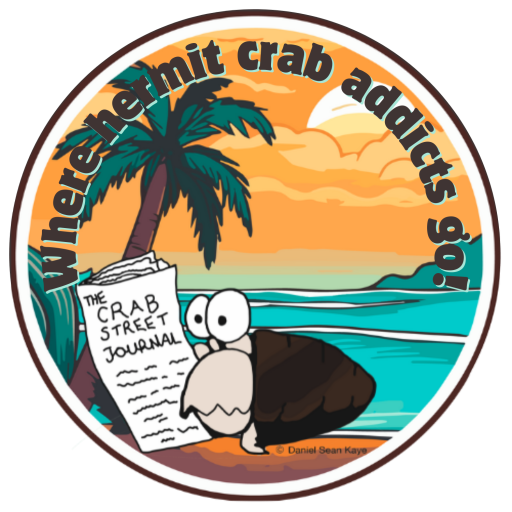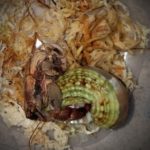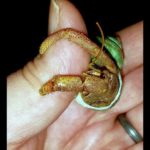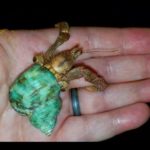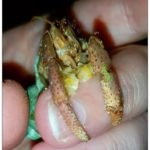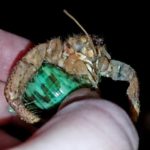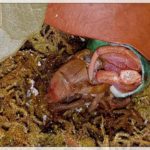I’d kept hermit crabs for roughly a year and a half prior to discovering the CSJ site, and – like many others – assumed I’d been properly caring for them, negating the need to further research their requirements…or anything about them, really. One doesn’t exactly discover troves of books dedicated to hermit crabs the way one discovers the same in regards to dogs, cats, birds, or any of the other, more typical household pets. Subsequently, one simply decides that not much must be known about them (or that what is known is too boring and/or limited to bear repeating in guide after guide), and so one makes do with the information provided by pet store employees. While I don’t recall the exact thing that led to my first Google search about them, I do recall that it was diet-related, as I became interested in offering foods other than the pre-packaged pet store fare. During the course of this search, I came upon the CSJ site and decided to poke around. I was quickly struck not only by the quantity of information present, but also its quality. In addition to locating more than I ever bargained for, or could have imagined I’d find, regarding food options – and nutritional needs in general – I found information on so many other factors involved in the crabs’ care: Substrate. Tank size. Heating options. Molting. Illness. And……..science. A college professor by trade, I’m not one to be convinced of something, especially animal-care-related somethings, unless there is appropriate back-up research involved. I found such evidence throughout the CSJ site (man, those hermit crab books and pet store employees were way off…), and it convinced me that the folks in charge here must be awfully invested in correct hermit crab care. Why else would the site be so thorough? Contain information proven through included research? Contain an option for receiving assistance in the event of an emergency? Contain a marketplace, where select food items could be purchased for unbeatable prices? I was sold. And encouraged. I did a bit of additional, outside research, found information from trustworthy sources that corroborated CSJ’s, and set about making changes to my own crabs’ set-up. CSJ opened the door not only to new knowledge, but to the fact that such knowledge actually exists and is freely available. It also opened the door to a desire to learn more, and to maybe even mingle online with others like myself: crab owners dedicated to giving their crustaceous kiddos the best life possible.
Fast-forward to a year-plus later, and I’ve continued to make regular use of the CSJ site. I’ve also, as a result of joining its affiliated (LHCOS) group on Facebook, discovered not just folks I enjoy interacting with in a general sense; I’ve found new friends…a new tribe, if you will…some of whom I had the pleasure of meeting in-person at the first-ever CrabCon in July of 2019, an event that allowed this truly-introverted gal to come out of her shell (come on; you knew such a reference was imminent). It was a surreal experience that continues to sit strongly in my memory, and it offered additional options for camaraderie and a sense of community/belonging. But, I digress.
On September 22nd, 2019, I awoke to find one of my small crabs on top of the substrate, shell-less and missing all limbs with the exception of two walking legs, one of which was injured. He was a pathetic sight at best, and though I did not have high hopes for his survival (he had, I assume, been assaulted under the substrate while molting), I plopped him into an iso container with a few shells of appropriate size, as his was nowhere to be found. It took him a couple hours to choose one, and when he did, he picked a green turbo that was clearly too small. This concerned me, but I was more relieved that he was at least strong enough, and possessed enough of a will to survive, to put on some pants. I posted a photo of him in his sad state to my personal Facebook page, and – not surprisingly – my CSJ friends were quick to weigh in with support and suggestions. When it became readily-apparent after a day or two that the crab truly wanted to live (he was moving, eating, and drinking, although the latter two activities involved my being hands-on with him, as he was missing both claws), I began regularly communicating with various CSJ administrators and moderators. I’d never been in this situation with a crab before, and obviously I was interested in ensuring this one’s survival. I knew the basics for caring for an incapacitated, limbless crab – thanks to the CSJ site – but I desired more specific assistance, and the aforementioned admins and mods were not only quick to advise, but pleasant, genuinely-helpful, and personally-interested, and invested, in this little crab’s well-being. The ever-lovely and thoughtful Mary Akers even mailed a care package that included nutrient-dense food appropriate for a clawless, recuperating crab. This is the level of commitment these people demonstrate…not just for the crabs themselves (in a collective sense), but also for each other and for those of us in the LHCOS group who demonstrate a willingness to learn and to do right by our hermits and by each other, as friends. I was – and continue to be – blown away by the support, and kindnesses, shown.
As a result of these wonderful folks’ efforts, which guided my own, my incapacitated crab, who has since come to be named William Robert (‘William’ because of his will to live, and ‘Robert’ thanks to a former student-turned-friend who regularly checked in by asking how ‘Bob the Crab’ was doing), successfully molted into wholeness in the overnight hours of October 12th, 2019. Two days later – and only 20 days after I found him lying helpless, naked, and nearly limbless in his tank – he continues to harden. I imagine it’s only a matter of time before I discover him picking away at the remains of his ordeal, in the form of his old exoskeleton, with the brand-new claws that he regrew under the watchful eyes of his many CSJ/LHCOS friends and advocates. Much love, and many thanks, to you all.
Sherri Werdebaugh
(Scroll for a series of photos, from the day I found him to the day he molted. )
